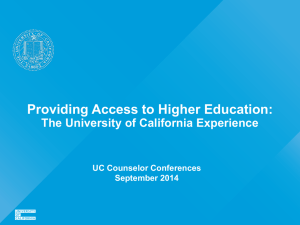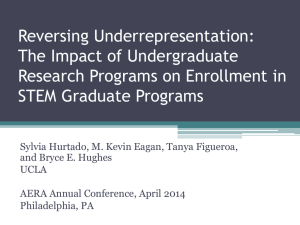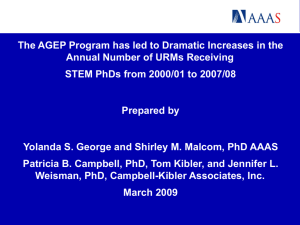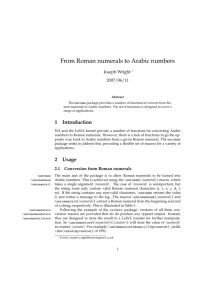View Powerpoint - NSF-AGEP
advertisement
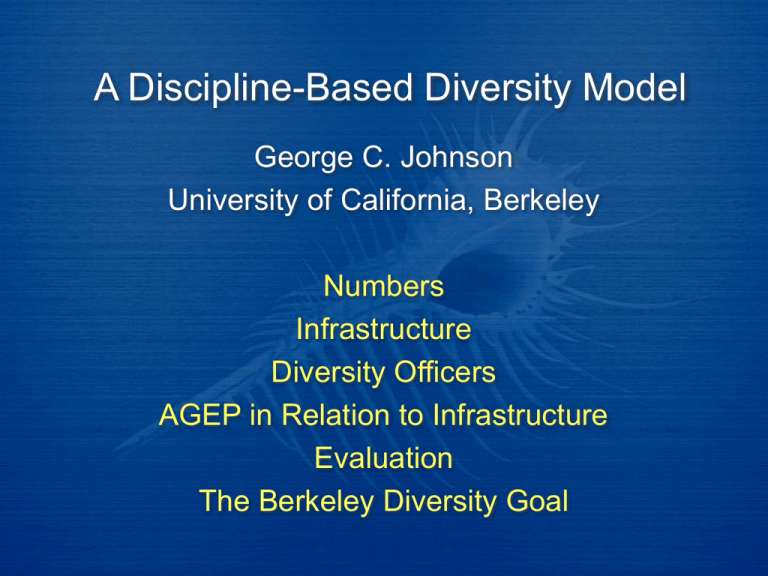
A Discipline-Based Diversity Model George C. Johnson University of California, Berkeley Numbers Infrastructure Diversity Officers AGEP in Relation to Infrastructure Evaluation The Berkeley Diversity Goal Numbers Total Apps. Total URM URM % of Apps Total Total Admits URM URM Admits % of Total Total Total URM New URM % of Enroll. Enroll. Total 9,230 326 1,786 116 802 3.5% 6.5% 56 7.0% Source: Graduate Division, UC Berkeley These are 5-year averages from 2001-2005 for applicants, admitted students and newly enrolled doctoral students across all STEM fields at Berkeley. Numbers (continued) Admission of URMs is at higher rate than non-URMs. URMs represent 3.5% of applicants and 6.5% of admits Yield rate of URMs is comparable to admissions rate, representing 7% of newly enrolled STEM Ph.D. students About half of both URMs and non-URMs who are admitted to Berkeley accept our offer of admission and enroll About 17% of all URM applicants enroll in our doctoral programs; compared to 8% of non-URM applicants A Key Element of the Berkeley Program: Discipline-Based Diversity Directors The Berkeley Diversity Model: a discipline-based diversity infrastructure UCOP, Assistant VP for Academic Advancement Physical Sciences Biological Sciences College of Engineering Graduate Division Dean Campus PI Dean co-PI Assoc Dean co-PI Dean co-PI Diversity Director (AGEP Director) Diversity Director Diversity Director Diversity Director Departments Departments Departments Departments AGEP Staff: Additional Management Team Members: • Associate Director Diversity Director, Electrical Engineering • Admin. Assistant Director of Graduate Fellowships The Role of Diversity Officers: responsibilities and areas of authority Report to the academic dean, involving the dean as needed Are high-level professionals, with PhDs or MAs and years of graduate diversity experience Have responsibility for the departments under the dean’s purview (Engineering 7; Phys. Sci.: 5; Bio. Sci.: 2) Advise the dean and departments on strategies to increase URM applicants, admissions, enrollments and degrees Serve as the “institutional memory” on diversity matters, student progress, experience with unusual applicants, etc. Work with departments, divisions and colleges in monitoring progress toward increasing diversity Diversity Officers: work in the departments on admissions Do outreach. Organize faculty, students, student services staff in the departments to conduct outreach Are members of admissions committees in some departments; in others serve as advisers. Review applications, contact applicants, advise admissions committees regarding particular applicants, suggest retention strategies for applicants when needed, help put together funding packages Work closely with the faculty affirmative action officers (each department is required to have one), the admissions chairs, the department chairs, and other faculty Diversity Officers: work on student retention and advancement Consult individually with all diversity students (particularly URMs and women) from outreach and recruitment through graduate training to degree completion Have the authority to intercede on behalf of students Raise funds and help faculty raise funds to improve diversity in the departments. This includes assisting departments in generating fellowship funds for URM students. Generally maintain contact with and continue to advise URM alumni after they graduate AGEP in Relation to Berkeley’s Diversity Infrastructure AGEP is integrated into our STEM and Graduate Division infrastructure (Deans are Co-PIs; diversity officers are Management Team) AGEP resources are distributed to students and departments through the diversity officers The AGEP-supported Berkeley Edge Conference contributes 10% of our new URM enrollments (and most BEC attendees enroll in STEM graduate programs somewhere, if not UCB) AGEP in Relation to Berkeley’s Diversity Infrastructure (continued) All new URM students are eligible for summer research funding through the LPFI- Berkeley Edge (AGEP) Summer Fellows Program. The AGEP team advocates for campus-wide change. For example, before AGEP, we had 3. 75 FTE diversity officers. The AGEP team aggressively promoted the diversity officer model on the campus. AGEP provided the proof of concept for other disciplines. There are now 7.0 FTE diversity officers. Evaluation Evaluation is embedded in the diversity officers’ work: They have access to their departments’ student records and Graduate Division-generated data on applications, admissions, enrollments, degrees They analyze these data, monitor progress for each of their departments, and advise department chairs and deans on changes Evaluation (continued) The diversity officers, Graduate Division deans, and faculty affirmative action officers meet twice each semester to review overall campus progress on diversity Our AGEP team meets periodically and communicates frequently to consider campus-wide STEM data, STEM policy issues related to diversity, UC AGEP matters. Our AGEP program stimulates innovation by focusing these key players on generating better approaches and models The Berkeley Diversity Goal: relentless, monotonic improvement We have a stable, intensive diversity infrastructure that is a solid vehicle for constant improvement In admissions, we are doing well. Improvement is needed to: Increase applications of eligible students Increase yield of admitted URM applicants Increase long-term retention and advancement of URM students (in some fields). Build community and improve the graduate school experience for URM students. We aim to have our Ph.D.s be the best ambassadors for science nationally. This will make STEM doctorates more attractive as an option for undergraduates and prospective graduate students

